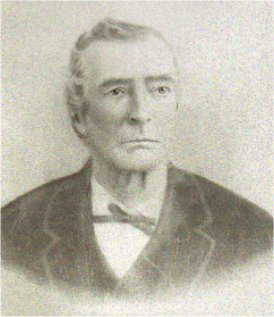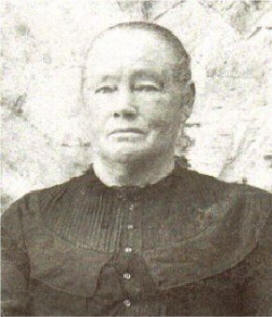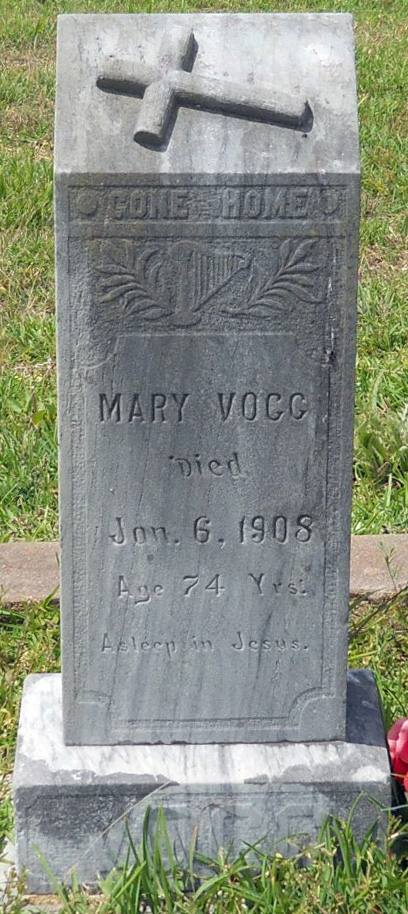| V |
Family of John Fredrick & Mary Haggerty Vogg |
V |
 |
 |
| John Fredrick Vogg, Sr. | Mary Haggerty Vogg |
|
Photos courtesy of Find A Grave
Volunteers Suzy and Rob #46950534 |
|
John Fredrick Vogg, Sr.
By Jeanette Lee Lukefahr
Matagorda peninsula was the home of John Fredrick Vogg and his family for approximately twenty years. Mary Haggerty, his future wife, came at the same time with her family. Together they survived destructive hurricanes, diseases and the Civil War. They left their mark as did many early pioneers in facing the unknown dangers of early Texas.
In 1853 John Fredrick Vogg left his home in Württemberg, Germany, for he had heard stories that the salty sea breeze would cure his facial skin cancer. He left from a seaport in England and journeyed for a distant seaport in America named Indianola. On board ship, he met and married Mary Haggerty from Black Rock County, Cork, Ireland.
John and Mary sailed through Pass Cavallo into Matagorda Bay where the ship dropped anchor. Here they rested until the bar pilot came to guide them into Indianola. As they stood looking out over the sleepy little seaport, palms gently swayed in the early evening breeze and candle lights glowed out a message of welcome. They were just a group of German-Irish immigrants with no home and little money.
Indianola was founded in 1844 when a settlement brought to Texas by Prince Carl of Solms-Braunfels sprang up at Indian Point, later to be called Old Town. When a storm wrecked the wharf, the settlement moved up the shore three miles where a pier was built and called Powder Horn. This became the site of Indianola. It lies on Matagorda Bay fifteen miles from what is now Port Lavaca. This port was used by many German-Irish immigrants.
Staying only a few days, John and Mary made their way to Matagorda Peninsula. There he bought certain lands on the Peninsula which are the following:
Fredrick Vogg from John Brady, 133 acres of Matagorda Peninsula, March
7, 1854, $50.00 in hand.
Fredrick Vogg from John McDonald, 1/2 of 614 acres of Matagorda
Peninsula, March 14, 1854, $307.00 in hand.
In the 1800s Matagorda Peninsula was very productive in all kinds of crops and garden vegetables. It was a very good sheep and cattle range. Fresh water could be found near the surface on the Gulf side. The peninsula was seventy-five miles long and from one to two miles wide. It connected to the mainland at Caney Creek and came to a focus at Decrow's Point. Many people preferred the peninsula for their homes because it seemed more healthful. A storm in 1854 brought disaster to all who lived on the peninsula. Those who escaped with their lives, were fortunate. The settlement was rebuilt and remained upon the peninsula until another storm brought it completely to an end in 1875.
While John and Mary lived on the peninsula, he raised sheep for money. Tobacco, watermelons, chickens, hogs, horses and milk cows were raised for their own use. The sea was plentiful with fish and crabs for them to catch and eat.
The family of John Fredrick Vogg prospered and increased in size. While
living on the peninsula they had six children:
Margaret Vogg
John Fredrick Vogg, Jr.
Hannah Vogg
Elizabeth Vogg
Mary Ann Vogg
Nora Ellen Vogg
The religious beliefs John followed were Lutheran and Mary was a Roman Catholic. They attended the Christ Church of Matagorda because it was close to their home and the only church for miles. the Parish of Matagorda, under the name of Christ Church, was organized February 27, 1839. The church was, also, the first Episcopal Church in Texas.
John and his family lived through four major hurricanes. The storm of 1854 hit after they lived there only six months. The storm of 1875 was the saddest to the Vogg family. They boarded their sloop to leave for the mainland for safety from the storm. . The sloop was caught in a wave and flipped on its side leaving the mast connected to the sloop and touching the bank. Hannah, holding Mary Ann’s hand, started walking across the mast when the sloop uprighted itself and threw Mary Ann into the water. Hannah grabbed the mast and held on. The family could not find Mary Ann so they went to seek shelter. John and Mary continued to search for the body after the storm. They met some people who had found the body of the little girl and had buried her. The dress Mary Ann had on fit the description of the dress on the body, so they always thought it was Mary Ann. After the storm the family moved to the mainland. They had lived on the peninsula approximately twenty years.
On the mainland, John Fredrick Vogg, Sr. bought certain lands which are the following:
Fred C. McCamly, et al, to Fred Vogg, $220.00 paid in hand for 200 acres of League #12 E. R. Wightman located close to Battle Island, June 24, 1878
J. W. Frost, et al, to Fred Vogg for the sum of $225.00 paid in hand for 440 acres of League #12 on Matagorda Bay granted by the Mexican government to Ira Ingram, December 13, 1884.
They lived in the Matagorda area approximately twenty-three years until July 20, 1901, when John Fredrick Vogg, Sr. died of cancer. Mary Haggerty Vogg continued to live there until January 6, 1908, when she died. They were buried in Matagorda Cemetery.
The Vogg name ended in the
third generation, but was carried on in descendants of the daughters.
|
|
|
|
Photos courtesy of
Find A Grave Volunteers Suzy and Rob #46950534 |
|
Below is the plot of land owned by John Fredrick
Vogg, Sr., when he lived on the mainland. This plot of land was
divided between the heirs of Mary Vogg after her death in the year
1908.

